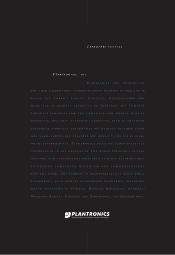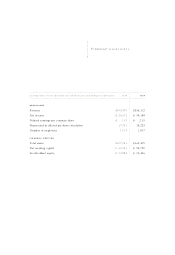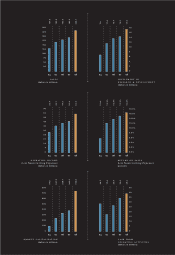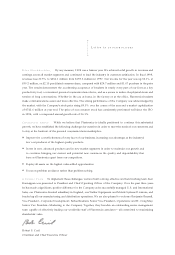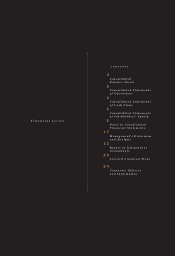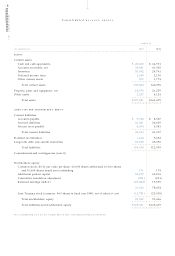Plantronics 1998 Annual Report Download - page 15
Download and view the complete annual report
Please find page 15 of the 1998 Plantronics annual report below. You can navigate through the pages in the report by either clicking on the pages listed below, or by using the keyword search tool below to find specific information within the annual report.
Notes TO CONSOLIDATED
FINANCIAL STATEMENTS
DEFERRED DEBT ISSUANCE COSTS
Debt issuance costs are assigned to the various debt instruments and amortized over the shorter of the terms of the
respective debt agreements or an estimated period the debt will be outstanding.
REVENUE RECOGNITION
Revenue is recognized when products are shipped. Provision is made for estimated potential customer returns and
warranty costs at the time of shipment.
CONCENTRATION OF CREDIT RISK
Financial instruments which potentially subject the Company to concentrations of credit risk consist principally of
cash equivalents and trade receivables. The Company’s cash investment policies limit investments to those that are
short-term and low risk. Concentrations of credit risk with respect to trade receivables are generally limited due to the
large number of customers comprising the Company’s customer base and their dispersion across many different
geographic areas. The Company performs ongoing credit evaluations of the financial condition of its customers and,
generally, requires no collateral from its customers. The Company maintains an allowance for uncollectible accounts
receivable based upon expected collectibility of all accounts receivable.
FAIR VALUE OF FINANCIAL INSTRUMENTS
The carrying value of the Company’s financial instruments, including cash, cash equivalents, accounts receivable, accrued
expenses and liabilities, approximate fair value due to their short maturities. The fair value of long-term debt, including
the current portion, was estimated by management based on current rates offered on the open market for debt of the
same remaining maturities. The fair value of the long-term debt was not materially different from the carrying value
of $65.1 million at March 31, 1998.
INCOM E TAXES
The Company accounts for income taxes under the liability method, which recognizes deferred tax assets and liabilities
for the expected future tax consequences of temporary differences between the tax basis of assets and liabilities and
their financial statement reported amounts. Tax credits are accounted for as a reduction of tax expense in the year
in which the credits reduce taxes payable.
FOREIGN OPERATIONS AND CURRENCY TRANSLATION
The Company has foreign assembly and manufacturing operations in Mexico, light assembly, research and development
and sales and marketing in the United Kingdom, an international finance, customer service and logistics headquarters
in Netherlands, and sales offices in Canada, Asia, Europe, Australia and South America. For fiscal 1997 and 1998, the
functional currency of all foreign operations was the US dollar. For fiscal 1996, the functional currency of all foreign
operations was the US dollar, with the exception of the operation located in the United Kingdom. Accordingly,
gains or losses arising from the translation of foreign currency statements and transactions, except for the operation
in the United Kingdom in fiscal 1996, are included in determining consolidated results of operations. Aggregate exchange
gains (losses) for fiscal 1996, 1997 and 1998 were $0.3 million, $0.4 million and ($0.2) million, respectively. Gains
or losses arising from the translation of the United Kingdom statements prior to fiscal 1997 were recorded as a separate
component of stockholders’ equity.
STOCK BASED COMPENSATION
Statement of Financial Accounting Standards No. 123, “Accounting for Stock-Based Compensation,” (“FAS 123”), encourages,
but does not require, companies to record compensation cost for stock-based employee compensation plans based
on the fair value of options granted. The Company has elected to continue to account for stock-based compensation
using the intrinsic value method prescribed in Accounting Principles Board Opinion No. 25, “Accounting for Stock
Issued to Employees” and related interpretations, and to provide additional disclosures with respect to the pro forma
effects of adoption had the Company recorded compensation expense as provided in FAS 123, (see note 10).
P.7
PLANTRONICS
ANNUAL REPORT . 199 8


